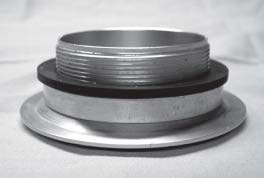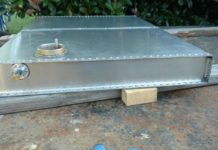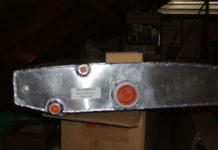Here is an option for sealing the flush fuel necks to the fuel tanks. If you have a metal lathe or have access to one you may want to consider this option which makes a fuel tight seal with a neoprene gasket.
 The first of the two photos show the two parts required, a neoprene gasket and an aluminum spacer ring.
The first of the two photos show the two parts required, a neoprene gasket and an aluminum spacer ring.
The spacer ring is machined from 1/2” aluminum stock. The side fitting to the neck flange has an angle machined to it that matches the angle of the flange. This side is bonded to the underside of the neck flange with any fuel proof product that will bond to aluminum ( ie; Proseal or one of the epoxies for bonding aluminum). A fuel proof gasket sealant will also work. The bottom of the spacer is flat to match up to the gasket.
 The second photo shows the assembly ready to screw into the tank boss. A light coating of grease on the gasket will allow the parts to turn smoothly over the gasket and prevent it from distorting when tightened. The wall thickness of the spacer can be 1/4” to 3/8”, but it’s O.D. should be inside of the welded edge of the tank boss. The I.D. should be such that it will be a snug as possible push fit on the fuel neck.
The second photo shows the assembly ready to screw into the tank boss. A light coating of grease on the gasket will allow the parts to turn smoothly over the gasket and prevent it from distorting when tightened. The wall thickness of the spacer can be 1/4” to 3/8”, but it’s O.D. should be inside of the welded edge of the tank boss. The I.D. should be such that it will be a snug as possible push fit on the fuel neck.
The height of each spacer must be a custom fit to each tank since the distance of the skin to the tank boss may vary for each tank. All of my skins were less than 1/2” from the tank boss. I chose to use 1/2” aluminum stock to make the initial fit-up. When the assembly was screwed tightly into the tank boss I measured the distance the neck flange was above the skin at its highest point around the flange. I added about 1/32” to that measurement, put the spacer back into the lathe and machined that amount off the bottom
I checked several sources for an off the shelf gasket but to no avail. I was able to get some made from a local rubber product supply for $2 each. They had dies for my I.D. and O.D. measurements. It would not be that difficult to cut them from a sheet of neoprene rubber with a sharp Exacto knife
These spacers are fairly easy to make. I made a set of four on the little $400 Harbor Freight lathe. I installed these mods on all four of my tanks over one year ago and they have remained sealed with no vapor leaks. I must add that there was nothing wrong with the method I originally used to seal the neck threads, which was with Loctite 565. I made the switch because I thought I had a vapor leak in the neck threads of one of the tanks but later found that wasn’t it.
Another reason is that since I completed my GlaStar I need to find things to do, like making things with my metal working tools.
See more fuel system tips.



